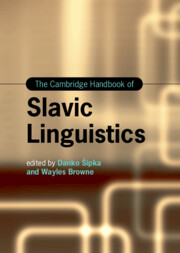Book contents
- The Cambridge Handbook of Slavic Linguistics
- Cambridge Handbooks in Language and Linguistics
- The Cambridge Handbook of Slavic Linguistics
- Copyright page
- Contents
- Figures
- Tables
- Contributors
- Introduction
- Part 1 Prosody and Phonology
- Part 2 Inflectional and Derivational Morphology
- Part 3 Syntax
- Part 4 Lexicon
- Part 5 Sociolinguistic and Geographical Approaches
- 26 Sociolinguistic Variation in Slavic Languages
- 27 False Cognates
- 28 Dialectal Fragmentation
- 29 Language Contacts
- 30 The Slavic Literary Micro-Languages
- 31 Heritage Language Forms
- 32 Scripts
- 33 Orthographies
- Part 6 Experimental and Quantitative Approaches
- Name Index
- Subject Index
- References
33 - Orthographies
from Part 5 - Sociolinguistic and Geographical Approaches
Published online by Cambridge University Press: 16 May 2024
- The Cambridge Handbook of Slavic Linguistics
- Cambridge Handbooks in Language and Linguistics
- The Cambridge Handbook of Slavic Linguistics
- Copyright page
- Contents
- Figures
- Tables
- Contributors
- Introduction
- Part 1 Prosody and Phonology
- Part 2 Inflectional and Derivational Morphology
- Part 3 Syntax
- Part 4 Lexicon
- Part 5 Sociolinguistic and Geographical Approaches
- 26 Sociolinguistic Variation in Slavic Languages
- 27 False Cognates
- 28 Dialectal Fragmentation
- 29 Language Contacts
- 30 The Slavic Literary Micro-Languages
- 31 Heritage Language Forms
- 32 Scripts
- 33 Orthographies
- Part 6 Experimental and Quantitative Approaches
- Name Index
- Subject Index
- References
Summary
Most Slavic orthographies are relatively shallow, relying on phonemic and morphological principles; other orthographic principles play minor roles. However, some orthographies with a rather unbroken tradition give the historical principle a certain role (like Polish or Czech); others rely heavily on the morphological principle (like Russian or to some extent Bulgarian). In some minor details (like comma rules or quotation marks) one can see different external influences, especially French and German. In the ways writing systems were adapted, the major split is between languages written in Cyrillic and those written in Latin. In the Latin alphabet, the main devices used are diacritics (nowadays especially those introduced by the Hussites) and digraphs, whereas Cyrillic hardly has diacritics or digraphs at all but uses special letters created from ligatures or with diacritic elements or borrowed from a different script. Spelling reforms over the course of history have generally strengthened the phonemic principle, unified orthography for a language, or increased or decreased differences vis-à-vis other languages in line with the political situation.
Keywords
- Type
- Chapter
- Information
- The Cambridge Handbook of Slavic Linguistics , pp. 697 - 714Publisher: Cambridge University PressPrint publication year: 2024



